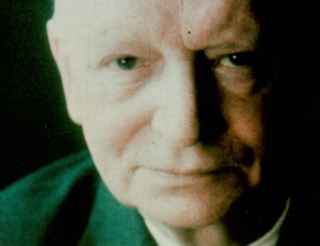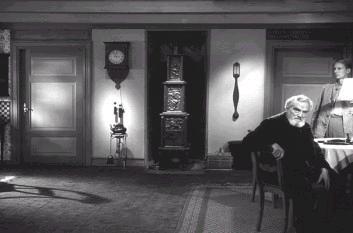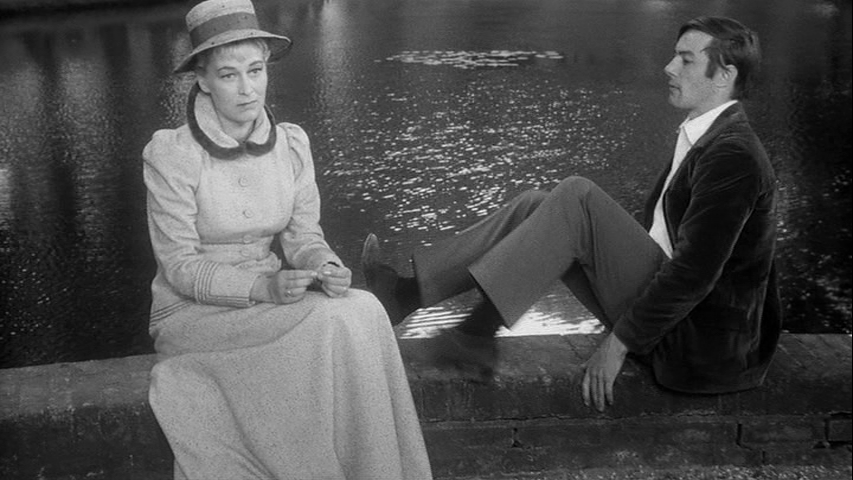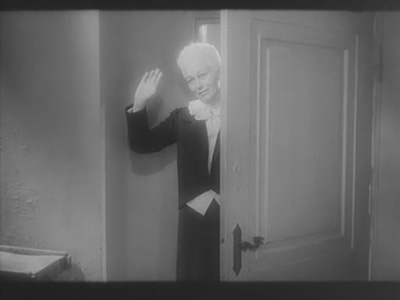From the November-December 1981 issue of Film Comment. I was gratified to learn from David Bordwell, via his own web site (as well as an email to me), that he’s eventually come around to agreeing with my major complaint about his book. (For an update to his link to my subsequent essay about Gertrud, go here. However, his link to this essay no longer works, so here’s one that does.)

The photograph of Dreyer immediately below is by Jonas Mekas. — J.R.
The Films of Carl-Theodor Dreyer by David Bordwell. 251 pp., illustrations, index, University of California Press, $29.50
In relation to Roland Barthes’ distinction between readerly and writerly texts, David Bordwell — an academic marvel who organizes huge masses of material with an uncanny sense of what can or can’t be assimilated –- should be considered a master of the teacherly text. His ambitious textbook written with Kristin Thompson, Film Art: An Introduction (Addison-Wesley, 1979), has rightly been regarded as a landmark to many film teachers — a sort of Whole Systems Catalog of formal registers in film that, like Dudley Andrew’s The Major Film Theories, makes a good bit of relatively difficult material accessible to students. Almost alone among prominent American film academics. Bordwell has drawn a lot of sustenance from the Russian formalists and more contemporary critics such as Noël Burch to articulate a modernist position that, for better and for worse, has avoided most of the ideological debates that his predecessors have engaged in.
In part because he has always defined his terrain as exclusively academic -– a teacherly approach in more ways than one -– Bordwell has not had to worry about those questions of national, existential, and vocational identity that have plagued most other formalists during this century, including Carl Dreyer himself. (His applications of Burch, for example, have always tended to domesticate and deradicalize aspects of his work, making them part of an acceptable syllabus.) Defining his turf as the range of his library, readers, and students, he doesn’t mind working out a method for studying Japanese cinema that accommodates some of the critical categories of André Bazin as well as Burch -– as he demonstrated at a conference in Milwaukee a couple of years ago –- even if this entails gliding past philosophical or political issues that might place Bazin and Burch at loggerheads with one another.
Disciplined and expedient about what he takes and uses from others, Bordwell is nothing if not pragmatic about his approach to formal film study. He includes criticism of his own previous work -– an early appreciation of Citizen Kane in this magazine (Summer 1971) extensively auto-critiqued in the anthology Movies and Methods and a critique of his Filmguide to La Passion de Jeanne d’Arc (Indiana University Press, 1973) –- if this brings him any closer to the clarity he seeks.
Many will not be able to afford the hefty cover price of his The Films of Carl-Theodor Dreyer. A beautiful object with large-format pages, beautifully illustrated throughout by many well-produced frame enlargements, this may be the most attractive of all the University of California Press’s book-length director studies to date, and belongs on the shelf of every devoted Dreyer lover. In contrast to Tom Milne’s useful and introductory The Cinema of Carl Dreyer (A.S. Barnes, 1970) and Mark Nash’s interesting if semi-unreadable Dreyer (BFI, 1977) -– the latter is tactfully and justly reviewed by Bordwell in a lengthy footnote — The Films of Carl-Theodor Dreyer represents the first coherent exposition in English if Dreyer as a modernist filmmaker, and for this reason alone stands as a seminal study that other critics and teachers will build upon.
The early chapters show Bordwell at his best in setting down many of the formal parameters and conflicts in Dreyer’s work. There’s the use of a book or privileged text (beginning with the first shot of The President, Dreyer’s first film) to guarantee “a teleology of closure” that frames each film as “a model of the adequacy of token to truth.” Then there’s a fascinating account of the construction of space in the early films, and the way that Dreyer’s use of the painterly and theatrical tableau conflicts with narrative logic and the latter’s control of cinematic space. This takes on an additional interest and coherence when Bordwell gets to Dreyer’s use of the closeup: “In order not to relinquish the tableau, Dreyer turns the face into a theatre.”
The latter emphasis naturally becomes a central aspect of Bordwell’s analysis of La Passion de Jeanne d’Arc, which is effectively and copiously illustrated with frame enlargements taken from the Danish Film Archive’s print of the movie — making this chapter, like most of the others, in part an impressive slide lecture. Yet it seems characteristic of Bordwell’s approach that sixteen of the twenty-six pages in this chapter pass before something as basic to the film as blood is mentioned, and in a seemingly unconscious way that could hardly be more oblique: “The [spatial] uncertainty at work within each composition bleeds across most of the cuts as well.”
One senses that, for Bordwell’s Joan of Arc, the “bleeding” of a formal attribute counts for more than the actual blood shed by Falconetti; and a few pages later, he’s discussing Joan herself as a formal device. In the chapter on Day of Wrath, “Christianity becomes Dreyer’s most powerful formal device,” while in Ordet, “If a character typically possesses traits, desires, wishes, Johannes is not a character. He is, rather, a formal need of the text, a manifestation of Ordet‘s demand for Christian legibility and narrative closure.”
The setting up and subsequent solving of problems becomes the focus of each chapter, with the Dreyer film often serving more as the medium than the message of the process. Consequently, the strength of Bordwell’s analytical grids and systems steadily grows as the book progresses, while the films themselves appear at times to shrink. In the chapter on Vampyr, there’s virtually no discussion of the film’s soundtrack or the incestual lesbian lust that’s mixed with the thirst for blood — two facets of Vampyr that I find fundamental — but the analysis of many of the more complex and ambiguously motivated camera movements and the diverse problems they raise are particularly illuminating.*
Occasionally, Bordwell’s absorption in his systems can make for a little unconscious humor. One chapter begins, “Day of Wrath is probably Dreyer’s most popular film, which already indicates something of the problem it poses.” (As a director who only managed to make about one feature per decade during the entire sound period, one wonders whether Dreyer might have appreciated the joke himself.) On the other hand, Bordwell’s flair for visual analysis remains striking and provocative:
One should not infer…that a chiaroscuro is statically laid against the decor, like the traceries in Morocco or the web-motif in Suspicion. In Day of Wrath, the blocks of light and darkness become visible only when a character passes through them. The steepness of many light sources is often not apparent in the static shot; figure movement is required to reveal the unexpected patches and angles of illumination. Even as simple a task as crossing a room or going to a door…becomes a stream of optical transformations, inducing the characters to penetrate a three-dimensional network of darkness and light. This effect is most pronounced at night, when the rectory’s volume is shot though with a light evoking the supernatural. As Ann circles Martin, she passes through thicknesses of light and shadow which are never projected onto the floor but which endow her with an aura at once mysterious and sexual.
***
Significantly, it’s only when Bordwell arrives at the incomparable Gertrud that the limitations of his approach come to the fore. The passionately personal, intransigent, and relentless aspects of the film seem to confound him because he can’t rationalize them sufficiently into formal properties, so he tends largely to limit his view of the film to reductive criticisms. “Thus the film’s tempo creates a constant supply of dead spots,” he writes at one point, “from which no narrative information is forthcoming.” It appears that he’s defining a dead spot as a moment “from which no narrative information is forthcoming”. This is a narrow piece of circular reasoning that fails to acknowledge the meditative dimensions of the film, a clear indication of Dreyer’s oft-expressed desire that the spectator reflect on what he or she sees and hears — think about the lines, for instance, and what they mean — and not merely be concerned with formal classifications.
The problem with Bordwell’s approach to Gertrud is that it simply draws a blank. Bordwell argues that the film possesses an “emptiness…[that] persistently seeks to negate meaning” — a curious hypothesis, insofar as emptiness is not ordinarily assigned a particular goal, much less a persistent one. But at this point in the argument, Bordwell is also willing to assign knowledge to a film rather than to a filmmaker or a spectator: “Knowing our desire to make the very absence of meaning significant, Gertrud does not actually destroy meaning; instead, the film proffers meaning only to withdraw it.”
Yet in fact, this is precisely what Bordwell does in his book — a sly bubble-dance that Gertrud cannot be accused of performing. And the critic’s withdrawal of meaning becomes, in effect, a denial of Gertrud’s towering and unbearable achievement. Thus a number of isolated elements in the film are reduced to clichés through Bordwell’s limited descriptions of them; these reductions are then labeled clichés so that we can be asked to consider Gertrud‘s (as opposed to Bordwell’s) “use of the cliché”. Within the space of a couple of more paragraphs, this has developed into the position that we can’t accept the film as either a tragedy or a work of religious art; ergo, as the old civil rights anthem has it, We Shall Not Be Moved: “In large part, the film’s persistent emptiness denies the richness and complexity, the meaning and pleasure, of ambitiously humanistic art. Gertrud refuses to be a great film. We cannot call it a masterpiece (or a failed masterpiece, or a failure). Gertrud‘s empty intervals declare it to be categorically against masterpieces.”
But the denial and refusal in this case are Bordwell’s, not Dreyer’s. A little later, he’s reverting to his (formerly persuasive) argument about privileged texts in Dreyer’s films; only this time he’s using his incomplete knowledge of Gertrud as a means of cinching his case, and I’m no longer convinced: “Earlier Dreyer films had halted us at the threshold of a secure authorial voice, a nondiegetic master meaning: the authorial word of the intertitles (Vampyr), Dies Irae (Day of Wrath), trial transcript and final title (Le Passion de Jeanne d’Arc) or Christian scripture (Ordet).”
According to Bordwell, Gertrud “refuse[s] to situate its narrative within such a framework.” But while he has even taken the trouble to compute the average shot length of Day of Wrath — 14.8 seconds, to be exact — he is more lackadaisical about discussing Gertrud in its integral form. Despite his assurance at the book’s beginning that “As much as possible, this book returns to the original texts,” he has not taken the trouble to discover that all American prints of Gertrud are missing four or five intertitles of rhymed verse that were removed by the distributor; indeed, to all appearances, Bordwell seems unaware that these intertitles ever existed — and continue to exist outside the U.S.**
It’s on this basis, in any case, that Bordwell can deny Gertrud the framework outlined above. I would argue, first, that the intertitled rhymed verses which mark the play’s five-act divisions — which are “spoken as if by an interior voice to the heroine,” as Elliott Stein has noted in his invaluable piece about the film in the Spring 1965 Sight and Sound — constitute precisely this framework; second, that beautiful as these intertitles are, at least in my memory, they alone scarcely suffice to convert Gertrud from an “empty” film into a fully rounded masterpiece.
So there’s more at stake here than a minor textual dispute. The problem, I think, is that, like Stein and Milne, I’m more concerned with Gertrud, while the final concern of Bordwell, like Nash, appears to be with his own methodology and categories. This is a brilliant book, but Dreyer is a filmmaker who (fortunately) goes well beyond brilliance — and Gertrud a film that goes well beyond Bordwell.
Note
*On the sequence in which Leone, after being attacked, is carried into the chateau, I had occasion to make some related observations of my own, in my review of the film in the August 1976 Monthly Film Bulletin — which I mention here only because Bordwell and Nash both fail to do so in their bibliographies. Considering the fact that they both also omit any references to James Agee or Robert Warshow on Day of Wrath, though, I consider myself in good company.
**2010 note: My own account here is somewhat inexact. For a fuller (if still incomplete) account, cf. my subsequent essay “Gertrud as Nonnarrative: The Desire for the Image”, which also reproduces in its third section (“Gertrud as Passage and Process”) all four of the intertitles in English translation.




















